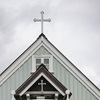(This model of renewal for declining congregations is based on The Servant-Witness Model for Congregational Renewal, which is explained in more detail in an upcoming book by Dan Bonner. Much of the work of implementing this model has particularly been centered on urban congregations.)
The servant-witness model for renewal consists of four interactive phases. For a church beginning the process of renewal action, there is a logical sequence to these phases. They are (1) mission development; (2) recruitment development; (3) small group development; and (4) prophetic witness development. Once all four phases are enacted, they continue to function simultaneously, each feeding the others within the congregational life of the revitalizing church.
Phase I: Mission Development
"When we began our efforts at renewal, the first thing we discovered was that we no longer had our fingers on the pulse-beat of the community around us," says Rev. Charles Stith of the Union Memorial Church in Boston. "We had to reacquaint ourselves with the struggles, hopes, and dreams of the people who live closest to us at Union Memorial. Before we could reach them, we had to show we cared about them."
The options for the approaches a church can take to mission development are numerous. The array of possibilities is limited only by the church’s ability and willingness to identify with the needs of its neighbors. Through these actions to meet human need, the church begins to reintroduce itself to its community as a dependable participant in people’s life struggles.
This first phase is missional when the church addresses basic human needs of hunger, housing, learning, or provides other human services. This is not missions in general. It is about the church addressing human needs in its midst. This may involve raising and giving money, but the basic ingredient is the personal involvement of church members with the life struggles of the community residents.
These actions do more than just provide assistance to the people being served. They also give church members, many of whom live in a different social setting miles from the church building, a growing sense of commitment to those who live around them.
This is an essential starting point from which the church can learn to identify its resources, both personal investment and money, with needs of people around it. Over a period of time, the community begins to see that within previously isolated church buildings, there is a congregation of people who want to become a dependable and cooperative presence in their lives.
Phase II: Recruitment Development
Once a city congregation develops direct services for meeting human needs in its community, new residents within the community around the church may begin to identify the church as an ally in their life-struggles. Through the personal contact of church members with community residents, the worshipping congregation may note a small but discernible upswing in visitors to the church on Sunday from within the community. These few visitors come partly out of curiosity and partly because members they are coming to know in their community intentionally invite them. But a major reason they come is to see if the spiritual longings they feel can be met in the congregation that is beginning to meet their physical needs.
The most important ingredient in a successful recruitment strategy for gaining diverse new members into a previously homogeneous church is intentional hospitality to the stranger. A wealth of biblical examples illustrate the importance of showing intentional hospitality to strangersr. Abraham greeted three strange men at the door of his tent as ambassadors from the Lord (Gen. 18:1-8). Conversely, so many refused to receive Jesus that he bemoaned his isolation, crying one day to an eager scribe, "Foxes have holes, and birds of the air have nests, but the Son of Man has nowhere to lay his head" (Mt. 8:20). These two biblical passages describe hospitality intentionally given by Abraham and hospitality consistently withheld from Jesus. Depending upon which of these two biblical responses greets the visitor, the city church will offer hospitality to the stranger which can lead to new fellowship or rejection, which will only further the church’s decline.
Jesus consistently sought out strangers and the outcasts. The tax collector (Mt. 9:9); a Samaritan prostitute (John 4); the lame, the blind, and the leper (Luke 14:13) were frequently touched by our Lord’s intentional hospitality. How can the renewing city church practice this same kind of intentional hospitality to the stranger who comes to worship today?
The mechanics of showing hospitality to strangers are often overlooked because members simply assume that anyone who comes to worship will feel welcomed. In most city churches nothing could be further from the truth! If visitors are rarely seen, the worship attendees easily fall into patterns of sitting in the same place, talking to the same people, and even greeting the same friends in the same spot in the narthex after the service. I often hear people say they have visited churches where no one spoke to them or even shook hands.
An example may best illustrate what can happen when a newcomer to an urban church experiences genuine hospitality. "Your church seemed to care genuinely that I came to worship," said a retired black woman living in a nearby public housing project after her first visit to predominantly Anglo church. "I came to your church because one of your members helped me find a bus last week. When I came in, I did not see any other black people, but the way your ushers and pastor greeted me made me feel like I was among friends, if not relatives." After this visitor came to the church, the pastor and several lay persons from her own age group visited her in her apartment the next week. Their concern about her well being in her new living arrangement increased the newcomer’s sense that the congregation was genuinely interested in her as a person and in her participation in the life of the church.
A second ingredient in an inclusive recruitment strategy is establishing new networks of growth. If the recruitment of the retired black woman into the Anglo congregation marked the end of this example, she would likely become an isolated token black face in an overwhelmingly Anglo worshipping body. Being isolated within the church is almost as problematic as being isolated from the church. But her story did not end there.
The pastor of this congregation urged her to invite her friends. Many of them were aware that the congregation was attempting to purchase and rehabilitate a building near their housing project to provide additional rent-assisted housing for the elderly. This human services initiative by the church gave the new member and her friends a growing sense that the church genuinely wanted to participate in their life struggles. Over a period of weeks the pastor visited the new member’s apartment complex often and held the first of a series of bible studies which the new member organized for her friends in the complex. Lay persons from the congregation participated in several of these studies. Within two months, four residents of the public housing project, all friends of the one new member of the church, united with the congregation.
While this aspect of recruitment is taking place, the congregation can also renew its efforts to reach and recruit persons who are similar to the old members of the previously homogeneous church. Many of these prospective members will live some distance from the congregational site and may be neighbors or friends of older members who still choose to drive back into their old neighborhood to worship and serve. Because the church has chosen to become a newly inclusive fellowship, the first signs of successful community recruitment will likely spark a new enthusiasm about the church in the old members. If the congregation encourages these members to consider themselves discoverer-evangelists within their own friendship networks, new people who fit the previous homogeneous profile of the church will come because they sense a new enthusiasm, vitality, and hospitality beginning to characterize the old congregation.
Phase III: Small Group Development
Having people join the church, particularly if those people represent a new diversity of ethnic, racial, economic, and age profiles from the traditional congregation, is only a second phase in the discipling process that will finally produce a truly inclusive church. As soon as community people with differing social profiles begin to unite with the church, new small groups must be developed within the life of the congregation to sustain their active participation. This small group development is the third phase in a city church's enactment of the servant-witness model for renewal.
The Korean Example of Inclusiveness
A dynamic illustration of the importance small groups play in the discipling process comes from the Methodist church in South Korea. Though western Protestant mission efforts began in this Third World country over a century ago, the development of a strong self-sustaining national Methodist church did not begin until the mid 1950s. Today that communion is the fastest growing national Methodist church in the world, reaching people in every social stratum of the country. In many city congregations the worshipping community includes army officers, business leaders, peasants, and factory workers. This great diversity occurs because of the strong small group life that is the foundation of Korean Methodism today.
By adapting John Wesley's two-century-old concept of class meetings, Korean congregations have achieved great strength through the small groups of Christians who gather together weekly for prayer, study, service, and social action. The size of the groups varies between ten and fifteen people. Each class meeting has a lay leader who uses the specially designed study material of the church to lead the weekly lessons. Other members of the group have special tasks: care for the sick, shut-in, and grieving members; provide social assistance to persons in the area with special needs; and visit absent members. This very disciplined structure functions with no direct dependence upon the ordained pastor, except that he or she meets regularly with all of the class meeting leaders in the congregation to instruct them in the preparation of their lessons.
Every class meeting is a small group made up of persons who share some common social, economic, or ideological frame of reference with the other members. This gives each group what we have previously called a homogeneous base. By organizing the groups in this way, members feel at ease with one another because they share something in common in addition to their Christian faith.
In some cases a Korean class meetings are made up totally of the extended members of a single family, guaranteeing a common economic, cultural, and language bond among the members. Other class meetings are organized among people who share a common political, ideological, or theological frame of reference but differ in age, geographic location, or economic status.
The Korean class meetings are constantly seeking persons outside the Christian faith who might be interested in joining them. Every member takes personal evangelization to be an important part of what it means to be a Christian. As visitors come to the class meetings, they are welcomed and encouraged to share in the group's life. If they find their spiritual and social needs being met within the group and the larger congregation's worship, they are encouraged to join the church and become permanent parts of the class meeting which discovered them. This zeal to find persons whose hearts are open to the presence of Christ is the key to the growth of the Korean Methodist Church.
As a group grows to near twenty, it divides into two groups. This multiplier effect means that the number of small groups in a congregation grows in direct proportion to the membership growth of the church.: It is the rarest of exceptions to find a Korean Methodist who is not an active part of a homogeneous class meeting. To prevent the class meeting from becoming little churches unto themselves, part of the discipline of each class meeting is to participate in the worship, pastoral support, and financing of the larger congregation. A typical Sunday worship service will include reports on highlights within the life of several class meetings. It is in the worship setting that the truly inclusive nature of the church is made clear. Within the joyful liturgies and Sunday fellowship hours, members of the congregation's homogeneous class meetings get to know each other as brothers and sisters in Christ. They work together to maintain the worship hall. They share in celebrating the victories of the various class meetings. They receive a common newsletter. Through these common ties, a sense of inclusive community develops within the church that honors the presence and participation of every person while, at the same time, upholds the study, fellowship, and service ministries carried on within the individual homogeneous class meetings. The result of this approach to renewal in Korea is that most congregations serving a pluralistic urban setting achieve a genuine inclusiveness across social, economic, and age boundaries. At the same time, it provides strong support for members through homogeneous small groups.(1)
Inclusiveness in North American Urban Churches
The lesson illustrated by the Korean Methodist Church for sustaining active church members across social, cultural, and economic lines is directly applicable to the renewing of urban congregations in North America. Just because a new black family who lives around the church joins one Sunday, there is no reason to believe they will become active if they are left in isolation. As soon as newcomers unite, they must find small group fellowships within the life of the church. It is within these small homogeneous group fellowships, church school classes, youth groups, choirs, women's and men's fellowships, that their Christian development can be nurtured over the long term. If no group exists that meets the needs of new members, new groups need to be formed so that, as in the Korean example, the growth of the congregation's small groups parallels the growth of new people in the church.
Once the renewal effort of the congregation advances to this point, recruitment is no longer understood as the province of a few evangelistic zealots, isolated newcomers from the community, or the pastor as occurred in Phase II. Now every small group is an evangelistic cell, actively seeking new persons who will feel at home within their homogeneous fellowship.
While small groups engaged in new member recruitment, they also become the base from which nurture and care of existing members occurs. The sick and grieving members of groups should receive much of their support during difficult times through the efforts of their small group.
In addition to caring for the current needs of group members, the group can care for inactive church members. By determining where these persons might fit within the profiles of a congregation's small groups, the pastor can provide group leaders with names of inactive members who can be effectively reactivated through special care and outreach. Very few long term inactive members of a church will find a new active role within the congregation simply by being encouraged to attend worship again. It is through their response to invitations to recreation, study, service, and fellowship activities of the small groups that they can develop new friendships within their old congregation, and become active members again. This important reactivation role of the small groups, particularly those groups already existing prior to the church's initiatives toward inclusiveness, is an important function of these cells.
It is this mosaic of homogeneous cells which creates a truly inclusive congregation. Through these small groups, personal faith is strengthened and a missional focus is clarified and enlivened. Over time, new congregational leaders also emerge from within these homogeneous fellowships.
Phase IV: Prophetic Witness Development
The Samaritan woman by the well was willing to give the Jewish stranger, or anyone else who passed, water from Jacob's well. She was willing to be inclusive if a Jew needed a drink badly enough to ask for it. It was a human service, designed to meet His human need, that made her willing to cross the barrier of social custom that hot day. But the man who stood before her used her openness to offer a new vision to her of what could happen between them that day. "Everyone who drinks of this water will thirst again, but whoever drinks of the water that I shall give him will never thirst; the water that I shall give him will become a spring of water welling up to eternal life" (Jn. 4:14).
Beyond missional aid lies new hospitality (the movement from Phase I, mission development, to Phase II, recruitment development). Beyond hospitality lies inclusive fellowship (Phase II, recruitment development, to Phase III, small group development). All of this process leads to a congregation in which the poor and not-so-poor, the Anglo and the black, the young and the old are all included. But included for what? The biblical message for the mature church that has grown into an inclusive fellowship is that their new solidarity at last enables them to grasp a vision of the most important agenda item God gives us—transformation. Water from Jacob's well is not all there is. We all can quench our thirst forever with the living waters of hope.
It is only as a renewing city church captures that vision of transformation and devotes itself wholeheartedly to participation in the transforming process that the city church in North America can realize its fullest potential. This realization leads the church from inclusive fellowship (Phase III) to prophetic witness (Phase IV), without diminishing the important work begun in the first three phases. the servant-witness model, it is when a church is able to unite in the enactment of Phase IV, prophetic witness, that the full flower of its renewal is achieved.
Because the church that is involved in the servant-witness model of renewal is becoming an inclusive church that binds together the rich and the poor, the young and the old, the Anglo, the Hispanic, and the black in a common fellowship where reflection and action can occur, these previously segregated groups within the community can band together to speak in one voice to the governmental and private sector forces that so strongly control the quality of their lives. As these experiences increase, the realization that God will use the church for the final transformation of this world into that Kingdom which is to come grows ever clearer.
However long it takes, however much it costs, we are committed to bridging any gulf which divides us from another. We exist under the lordship of the One who says in the cross of Calvary that this is the way.
(1) The source for the discussions concerning the Korean small groups is the Rev. Finis B. Jeffery, United Methodist missionary in South Korea, who has been involved for thirty years in their development








